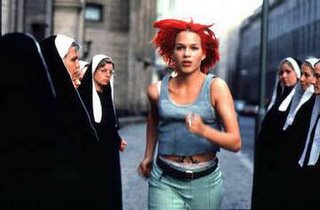
After reunification, the German film industry must have felt like it could do it on its own again. They didn’t want the mega-blockbusters from America of the 1980s anymore. They returned to making movies that seemed German. They returned to making popular cinema (Hake 179).
“Addressing themselves explicitly to German audiences, the films of the 1990s sought to accommodate the audience’s contradictory desire both for less complicated narratives of Germanness—including in terms of national identity—and for more optimistic visions of a multi-ethnic, multicultural society” (Hake 180). The films were being influenced by a wider world, now known to all of the German populace and not forbidden. Romantic comedies emphasized the power of the woman “wanting it all.” Road movies, while based on the Hollywood formula, were very German in that they emphasized an openness of values with middle-class attitudes. These were more optimistic films.
The films of post-unification Germany also were enhanced by the new distribution systems of the day, with video and television. The huge national corporations made these viable products. These globular concerns were easy to foster in these companies.
Run Lola Run highlights this new tendency in German film. It is a movie without a complete linear structure, sometime repeating whole events for a change of outcome. In a way, it understands its own medium by presenting the audience with something comfortable again and again, in MTV-like staccato images, so the audience roots for a new and better ending. The characters are down on their luck, yet still have the morals to not want to do bad things. The repeating of events to get a new result reads like a Choose Your Own Adventure book, letting the audience seem to pick the ending it likes best, or until the characters get it right, much like a video game.
When Sabine Hake in German National Cinema says that the German film characters of the 1990s were “well-adjusted, upwardly mobile, reasonably happy” yet “incredibly self-centered” (186), the characters of Run Lola Run come of age. The new social and economic avenues that Germany was traveling were adolescent in their own way. These films of the 1990s seem to be the attitudes of a real teenager. Everything is fun and joyous and the party will never end.
Run Lola Run has characters that thought the world was going to be easy. When a problem comes up that they don’t know how to handle, they have a moral quandary. Should they take the immoral way and steal or should they deal with the problem, whatever it may entail? Lola at one point runs to her own father for the money, as many teenagers will do when they get in over their heads. This could symbolize the Germans running for economic cover. However, the father has his own problems, some not moral themselves, and even shouts at the daughter that she wasn’t his anyway, but a child from the mother alone. This is what he inherited, much like the legacy that Germany must deal with. So Lola runs, to clear her head, to figure out what to do. Even though it seems at times to be repetitive, like running on a treadmill, she is making the moral decision and strengthening the resolve within.
No comments:
Post a Comment